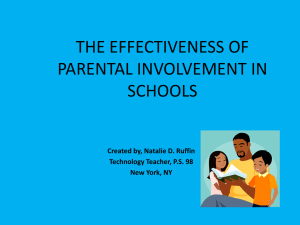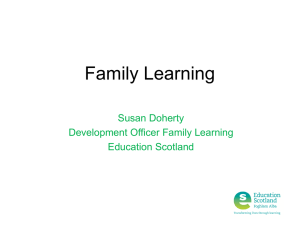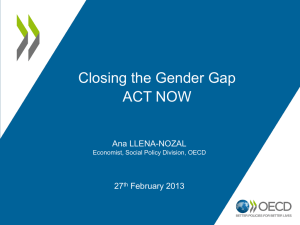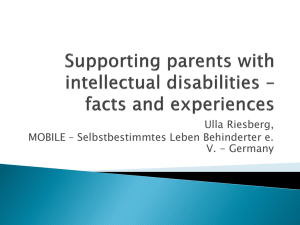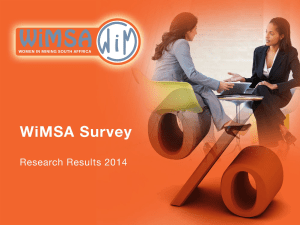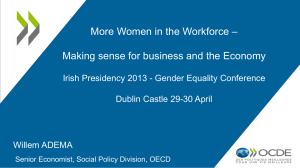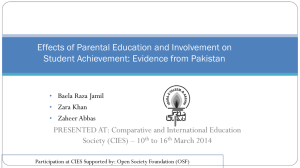peter moss presentation - Families and Work
advertisement
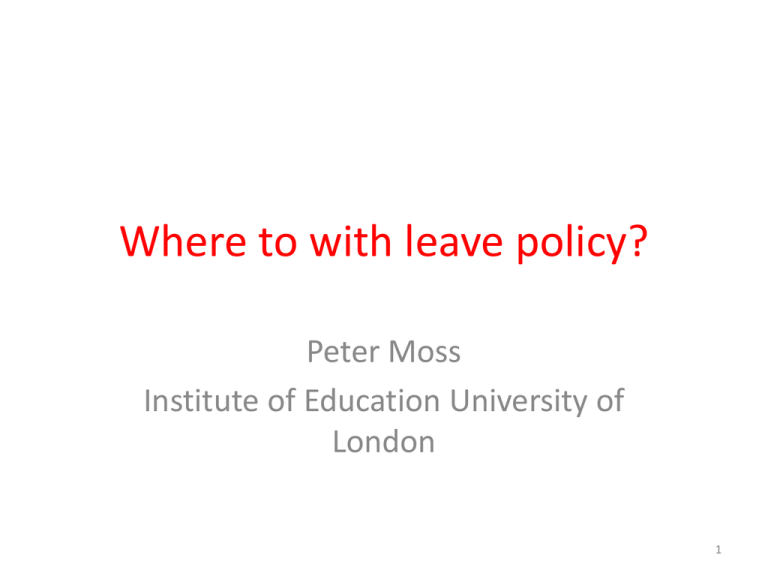
Where to with leave policy? Peter Moss Institute of Education University of London 1 1. Ireland in a European context 2. Some trends in parental leave 3. Rationales and designs for parental leave 4. Where to? Beyond parental leave But first…. 2 Network on Leave Policy and Research Annual International Review Country notes for participating countries: – details on leave(+other work/family measures) – take-up – recent policy developments – publications and research – relationship with ECEC 2014: 35 countries – 26 European (23 member states + Norway, Iceland, Switzerland) Available at www.leavenetwork.org 3 Three basic types of leave • Maternity leave: health & welfare mothers • Paternity leave: support and care fathers • Parental leave: care – equally for both parents But distinctions blurring in some countries 4 1. Ireland in a European context 5 Ireland in a European context European situation (26 countries) Post-natal leave periods MatL(mn) None 4 Length 1.9-12 Average 3.7 PatL(wk) 9 0.2-13 2 ParL(mn) 1 6-36 12.6 6 Ireland in a European context European situation (26 countries) Post-natal leave periods - well paid MatL(mn) None 1 Length 1.4-12 Average 3.3 PatL(wk) 2 0.2-13 2 ParL(mn) 12 6-24 11.5 7 Ireland in a European context Current Irish provision in relation to 26 European countries Maternity leave: very long…none well paid Paternity leave: 1 of 9 with none Parental leave: minimum possible by EU law ALL leave: 18 months v 36 months average 8 Ireland in a European context Current Irish provision in relation to 26 European countries Flexible work: 1 of 3 where right to request + Portugal has entitlement Reduced hours: no entitlement (11 countries do – 4 unqualified) Overall: • only country with no well paid leave • maternalist policies, i.e. assumes women responsible for care of very young children 9 2. Some trends in parental leave policies (NB. Now using ‘parental leave’ to cover all types of leave for parents with young children) 10 Some trends in parental leave policies • ‘Maternity’ leave transferable to fathers in normal conditions e.g. Czech Republic, Poland, Spain, UK • Three leaves reduced to single Parental leave with quotas for mothers/fathers/family e.g. Iceland, Norway, Portugal, Sweden • Growing attention on fathers – Paternity leave – Design of Parental leave to encourage use 11 Three important European cases • Iceland, Germany, Portugal • All made major changes since 2000 • All redesign leave to encourage fathers’ use: – Well paid, father only leave period OR – ‘Sharing Bonus’ OR – Leave obligatory • No separate Maternity leave in 2 cases 12 The case of Iceland No maternity leave 2001-33+3+3 ‘birth leave’ model (3 months each for mothers/ fathers/family @ 80% of earnings; non-transferable) 2010 • 95 fathers take leave for every 100 mothers • Fathers take 1/3rd of all leave (92 days v 179 for mothers) • Most fathers take ‘father only’ quota – but only 17% take part of ‘family’ quota v. 93% of mothers 13 The case of Germany West Germany goes East German 2006: 36 months low paid leave; family entitlement – 3.5% of fathers take some 2007:12 months well-paid leave + bonus 2 months if both parents take at least 2 months 2012: 29% of fathers take some...but 78% take only 2 months 2013: entitlement to ECEC from 12 months of age. West Germany has adopted East German policies! 14 The case of Portugal No maternity leave and obligatory leave for fathers ‘Initial Parental leave’: 120 cal.days @ 100% OR 150 @ 80%[45 days obligatory for mother, rest transferable]... IF father takes 30+days 150 days @ 100% OR 180 days @ 83% ‘Father’s only Parental leave’: 20 working days @ 100% - 10 days obligatory ‘Additional Parental leave’: 3 months per parent@25% 15 The case of Portugal No maternity leave and obligatory leave for fathers Other measures: • 2 hours/day ‘nursing leave’ up to 12 months; parents can share; paid • Right to flexible work until child 12 years (choose start and finish times) 2013: 24% of families share Initial Parental leave…68% of fathers take obligatory Paternity leave, 58% remaining period. 16 3. Rationales and designs for parental leave 17 Rationales and designs for parental leave What rationale(s) for Irish leave policies? • • • • • • • • • Health and welfare…of mothers? of children? Other child outcomes? Gender equality? Children’s right to parental care? Fathers’ and mothers’ right to spend time with their young children? Increase birth rate? Support ‘traditional’ gendered family roles? Improve family life? Improve workplace performance? 18 Rationales and designs for parental leave 1. Decide rationale(s) and goal(s) for leave policy…where to? 2. Identify and involve interested parties 3. Design for rationale(s)…5-10 year development programme + design for diversity, e.g.lone parent; same-sex parents; disability 4. Set short and long-term targets + monitor 5. Review and revise 19 Rationales and designs for parental leave • If health and welfare: How long is justified? Obligatory or voluntary? If voluntary, what conditions, e.g. well paid? • If gender equality: need well-paid, ‘father only’ period. Obligatory or voluntary? • Which model? – Maternity+Paternity+equalParental leave OR – Parental leave, e.g. 5+5+2 or 6+6 or ??? 20 4. Where to? Beyond parental leave 21 Beyond parental leave Parental leave is important but • As one of a number of measures • As part of a far bigger picture We need to get parental leave right – but think beyond it We need to know where to - where do we want to get to as a society? what future do we want? 22 Beyond parental leave How does parental leave relate to other policies for children? • Parental leave and ECEC: Large gap between entitlements in Ireland – and most countries • Parental leave and health: Is leave policy informed by health policy? Leave for child illness? • Parental leave and children’s rights: Leave policy usually made without any reference to/input about children’s rights and best interests. How might the ‘best interests of the child’ principle be interpreted? 23 Beyond Parental leave What relationship between employment, care and gender over the lifecourse? • Leave policies of limited use if only for a short period in a long lifecourse • Lifecourse ‘career break’ model: period of paid leave over lifecourse to be used for various reasons (e.g. Belgium) 24 Beyond Parental leave How does parental leave relate to relationship between employment, care and gender over the lifecourse? • Leave policies of limited use if no fundamental change in workplace practices and norms…having to request flexible work implies workplace norm continues to be full-time, continuously employed (male) worker • Flexible working as standard practice and adopt ‘universal caregiver model’ as norm… 25 Universal caregiver model [T]he trick is to imagine a social world in which citizens’ lives integrate wage earning, caregiving, community activism, political participation, and involvement in the associational life of civil society – while also leaving time for some fun. This world is not likely to come into being in the immediate future, but it is the only imaginable postindustrial world that promises true gender equity. And unless we are guided by this vision now, we will never get any closer to achieving it (Nancy Fraser) 26 Beyond Parental leave Without working towards a lifecourse perspective to relationship between employment, care and gender we face: • A growing crisis of care – who will do the caring in our societies? • A growing crisis of participation in public work – how can we be concerned citizens? • An environment inimical to individual or societal flourishing – how can we have a life worth living? 27 peter.moss@ioe.ac.uk 28
